Nothing beats the comfort of tender corned beef and cabbage simmering away in a Dutch oven. This one-pot wonder transforms simple ingredients into a hearty feast that’ll fill your kitchen with incredible aromas and bring everyone to the table.
We’ve perfected this classic recipe to deliver fall-apart tender beef paired with perfectly cooked vegetables. The Dutch oven’s even heat distribution creates magic – breaking down tough fibers while infusing every bite with rich flavors. It’s the kind of meal that turns ordinary weeknights into something special.
Whether you’re celebrating St. Patrick’s Day or simply craving soul-warming comfort food, this recipe delivers restaurant-quality results with minimal effort. The best part? Everything cooks together in one pot, making cleanup a breeze while maximizing flavor.
Ingredients
We’ve carefully selected each ingredient to create the perfect balance of flavors and textures in our Dutch oven corned beef and cabbage. These quality ingredients work together to produce a tender and satisfying meal that feeds the whole family.
For the Corned Beef
- 3 to 4 pounds corned beef brisket with spice packet
- 8 cups water (or enough to cover the beef)
- 2 tablespoons brown sugar
- 1 large yellow onion, quartered
- 4 garlic cloves, smashed
- 2 bay leaves
For the Vegetables
- 1 medium head green cabbage, cut into 8 wedges
- 1.5 pounds small red potatoes, halved if large
- 1 pound carrots, peeled and cut into 2 inch pieces
- 3 celery stalks, cut into 2 inch pieces
- 1 large parsnip, peeled and cut into chunks (optional)
For the Seasoning Blend
- 1 teaspoon whole black peppercorns
- 1 teaspoon coriander seeds
- 1/2 teaspoon mustard seeds
- 1/4 teaspoon red pepper flakes
- 2 tablespoons fresh parsley, chopped (for garnish)
- Coarse sea salt to taste
- Whole grain mustard for serving
Equipment Needed
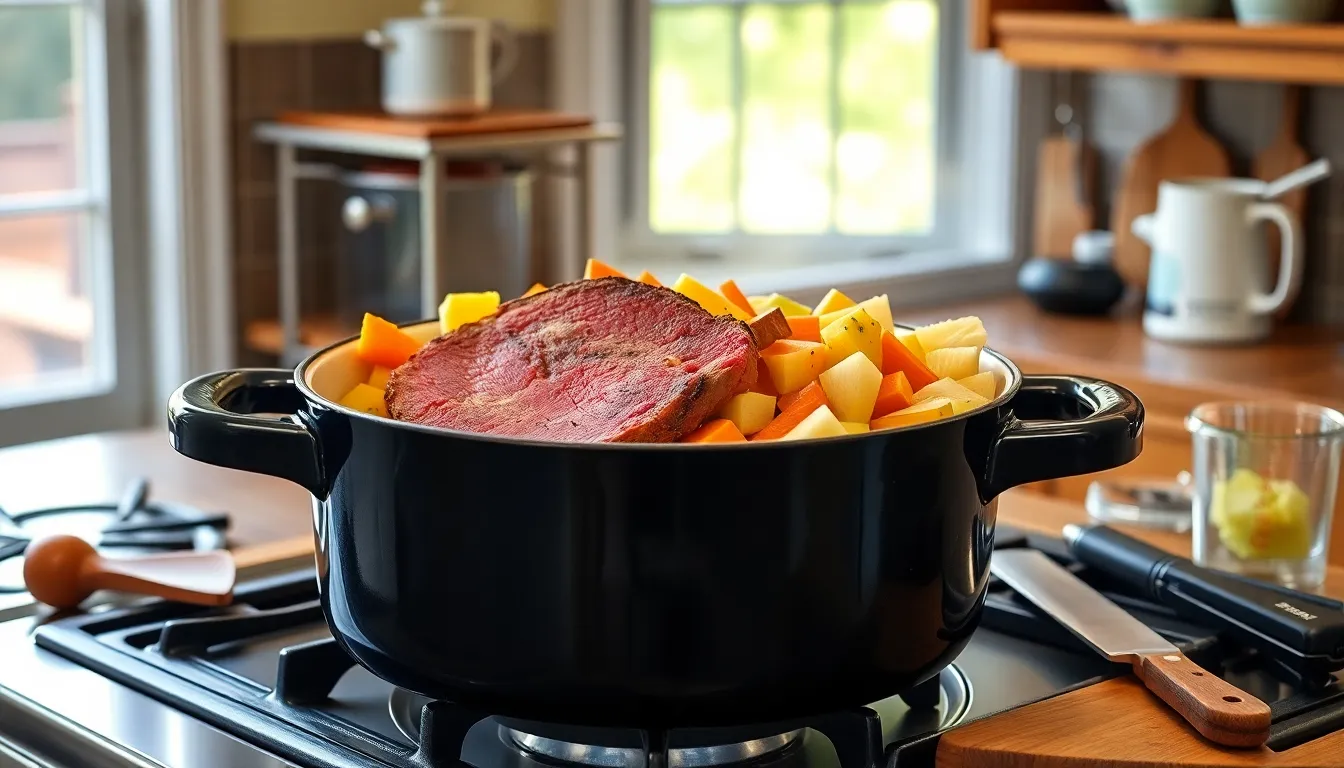
We recommend gathering exact equipment before starting this Dutch oven corned beef and cabbage recipe to ensure smooth cooking and optimal results.
Large Dutch Oven forms the foundation of this recipe. We need a 5.5-quart minimum capacity Dutch oven, though we strongly recommend using a 7-quart size to accommodate the 3-4 pound brisket and all vegetables comfortably. The Dutch oven must be suitable for both stovetop and oven cooking since our method involves searing on the stove and slow cooking in the oven at 300°F.
Wooden Spoon or Flat Spatula becomes essential for stirring ingredients and flipping the corned beef during the searing process. These tools won’t scratch the Dutch oven’s surface while providing the leverage needed to handle the large piece of meat.
Sharp Knife and Cutting Board are required for preparing our vegetables efficiently. We’ll be cutting potatoes, carrots, onions, and cabbage into appropriately sized pieces that cook evenly alongside the beef.
Measuring Cups and Spoons ensure accuracy when adding the 4 cups of beef broth, 16-ounce can of stout beer, and various seasonings. Precise measurements create the perfect braising liquid that tenderizes the meat and infuses flavor throughout the dish.
Neutral Cooking Oil such as avocado oil is needed for the optional searing step. This high-heat oil won’t burn during the searing process and adds no competing flavors to our carefully balanced recipe.
Having these tools ready before we begin cooking streamlines the entire process and helps achieve the tender, flavorful results that make this Dutch oven method superior to other cooking techniques.
Prep Work
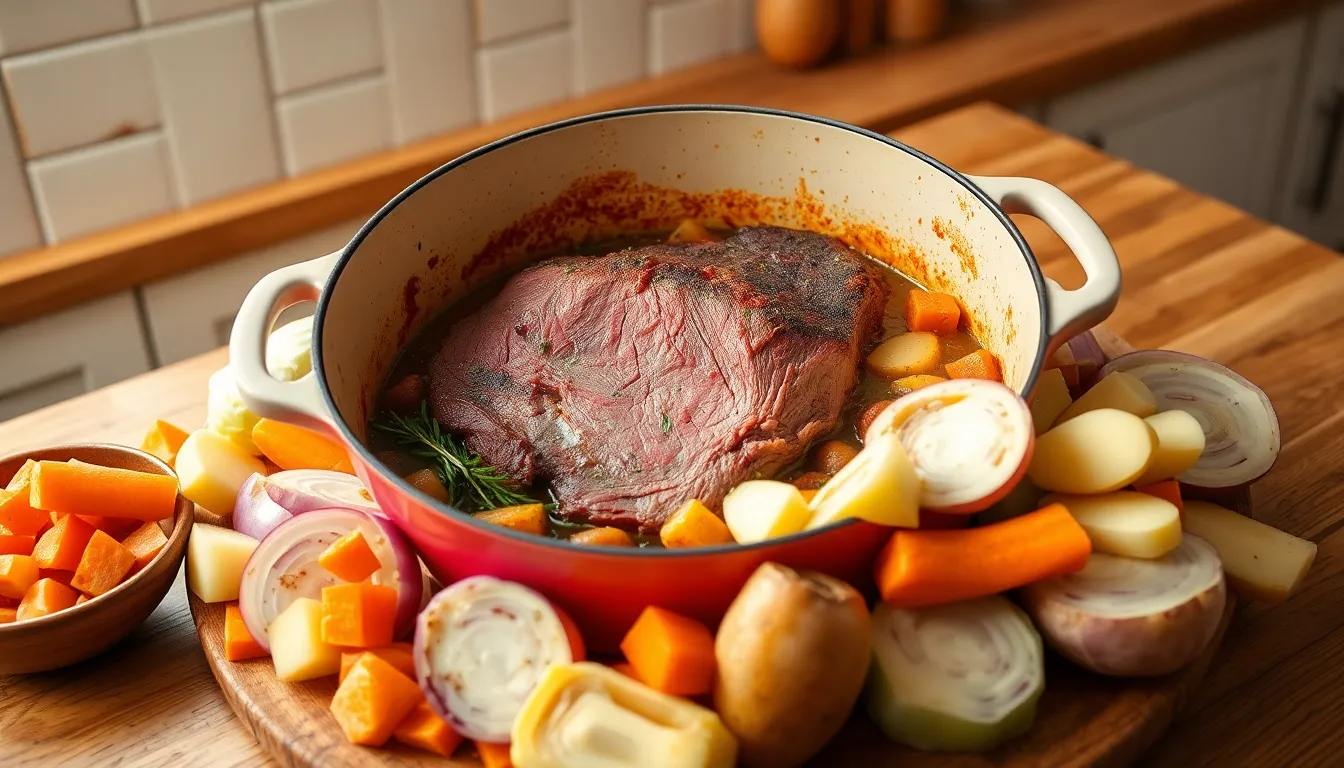
Proper preparation sets the foundation for tender corned beef and perfectly cooked vegetables. We’ll walk you through the essential steps to prepare both the meat and vegetables for optimal results.
Preparing the Corned Beef
We start by selecting a 3 to 4-pound corned beef brisket that includes the spice packet. Rinse the brisket under cold water to reduce excess salt if desired.
Place the brisket in your Dutch oven and add enough liquid to just cover the meat. We recommend using water or a mixture of beef broth and stout beer like Guinness for enhanced flavor depth.
Add the included spice packet along with 2 bay leaves to the pot. For extra flavor enhancement, stud an onion with whole cloves and add it to the liquid.
Bring the mixture to a boil over medium high heat. Once boiling, reduce the heat to low and cover the Dutch oven with its lid.
Allow the brisket to simmer for 2 to 2.5 hours until it becomes fork tender. Skim off any foam that rises to the surface during the simmering process to maintain clear cooking liquid.
Preparing the Vegetables
Yellow, red, or baby red potatoes work best for this recipe. We use approximately 1.5 pounds, cutting them into halves or uniform chunks for even cooking.
Peel 1 pound of large carrots and cut them into 2-inch pieces. Alternatively, use 5 to 7 medium carrots prepared the same way.
Take one large yellow onion, peel it completely, and quarter it into even sections. The onion pieces should be substantial enough to hold their shape during cooking.
Core a medium to large head of green cabbage and cut it into wedges or large slices. Keep the wedges intact by leaving some core attached to each piece to prevent them from falling apart during cooking.
Prepare all vegetables before adding the corned beef to the pot, as timing becomes crucial once the cooking process begins. Having everything ready ensures smooth execution and perfectly coordinated cooking times.
Instructions
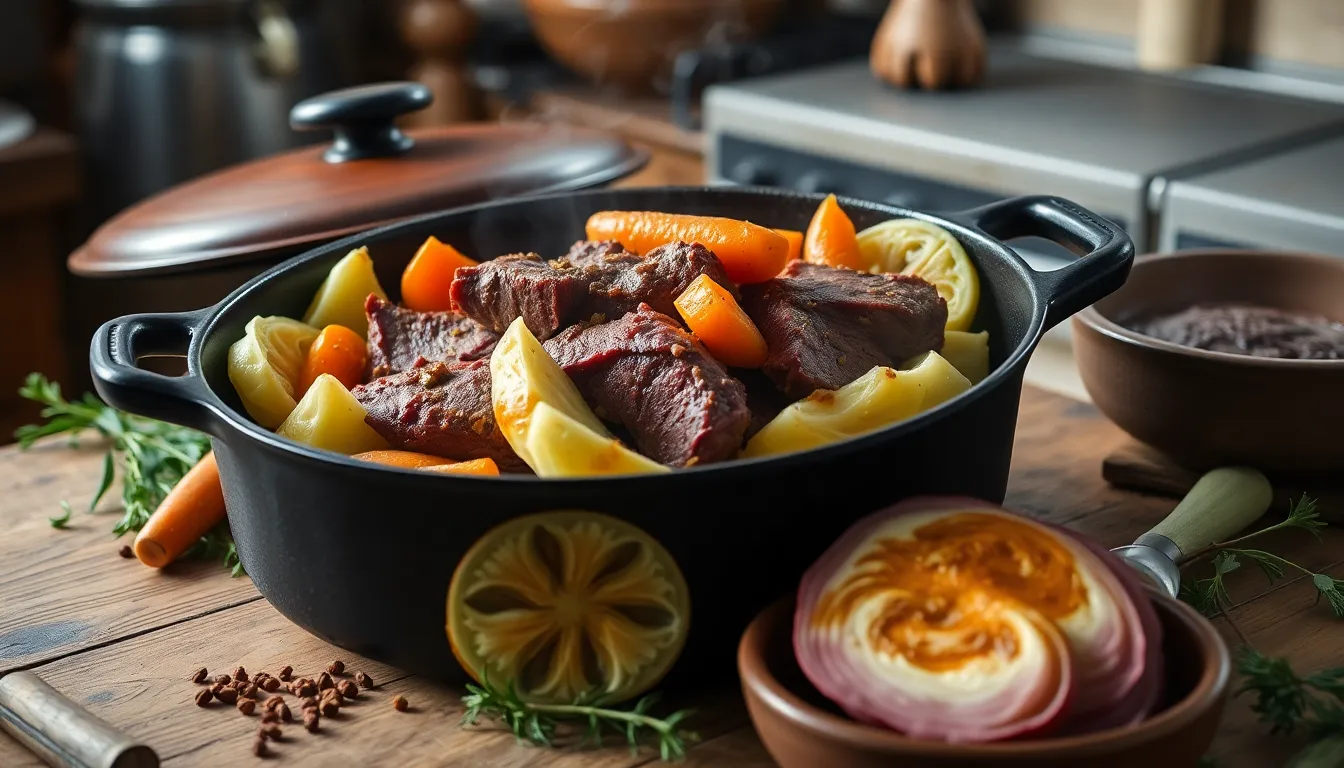
We’ll guide you through each step to create perfectly tender corned beef and flavorful vegetables using the Dutch oven method. These detailed instructions ensure consistent results every time.
Searing the Corned Beef
We start by optionally searing the corned beef brisket to develop deeper flavor and create a beautiful browned crust. Heat a small amount of neutral oil in your Dutch oven over medium-high heat. Pat the rinsed brisket dry with paper towels and place it in the hot pot. Sear each side for 3-4 minutes until golden brown. This step adds extra flavor depth though many traditional methods skip searing and move directly to simmering.
Building the Base Layer
We create a flavorful foundation by placing onion wedges at the bottom of the Dutch oven. Arrange the quartered onions evenly across the pot bottom to prevent the meat from sticking. Add bay leaves between the onion pieces for aromatic enhancement. Some cooks prefer to stud the onions with whole cloves for additional warming spices that complement the corned beef’s natural flavors.
Adding Liquids and Seasonings
We position the prepared corned beef brisket on top of the onion layer fat side up. Sprinkle the included spice packet evenly over the meat surface. Pour enough liquid to completely cover the brisket using water, beef stock, or dark beer like Guinness for richer flavor. Bring the mixture to a rolling boil over high heat then immediately reduce to maintain a gentle simmer. The liquid should bubble slowly and steadily without vigorous boiling.
First Cooking Phase
We cover the Dutch oven and cook the brisket at a low simmer for 2-3 hours depending on size. Calculate approximately 40-45 minutes per pound for proper tenderness. Skim any foam that rises to the surface during the first 30 minutes of cooking. Test doneness by inserting a fork into the thickest part of the meat. The brisket is ready when the fork slides in easily and the meat feels tender throughout.
Adding the Vegetables
We prepare the vegetables while the meat cooks by cutting potatoes into 2-inch chunks and carrots into diagonal pieces. Add potatoes, carrots, and additional onion wedges to the pot after the initial cooking phase. Cook these sturdy vegetables for 15-20 minutes until they begin to soften. Cut the cabbage into 6-8 wedges and place them on top of the other vegetables. Spoon some of the flavorful broth over the cabbage wedges before covering the pot again.
Final Cooking Phase
We continue simmering gently for 25-35 minutes until the cabbage and all vegetables reach perfect tenderness without becoming mushy. Remove the corned beef from the pot and let it rest for 15 minutes before slicing. Slice against the grain in thin pieces for maximum tenderness. Season the vegetables and broth with salt and pepper to taste. Serve the sliced corned beef over the cooked vegetables with mustard or horseradish sauce on the side.
Cooking Tips for Dutch Oven Success
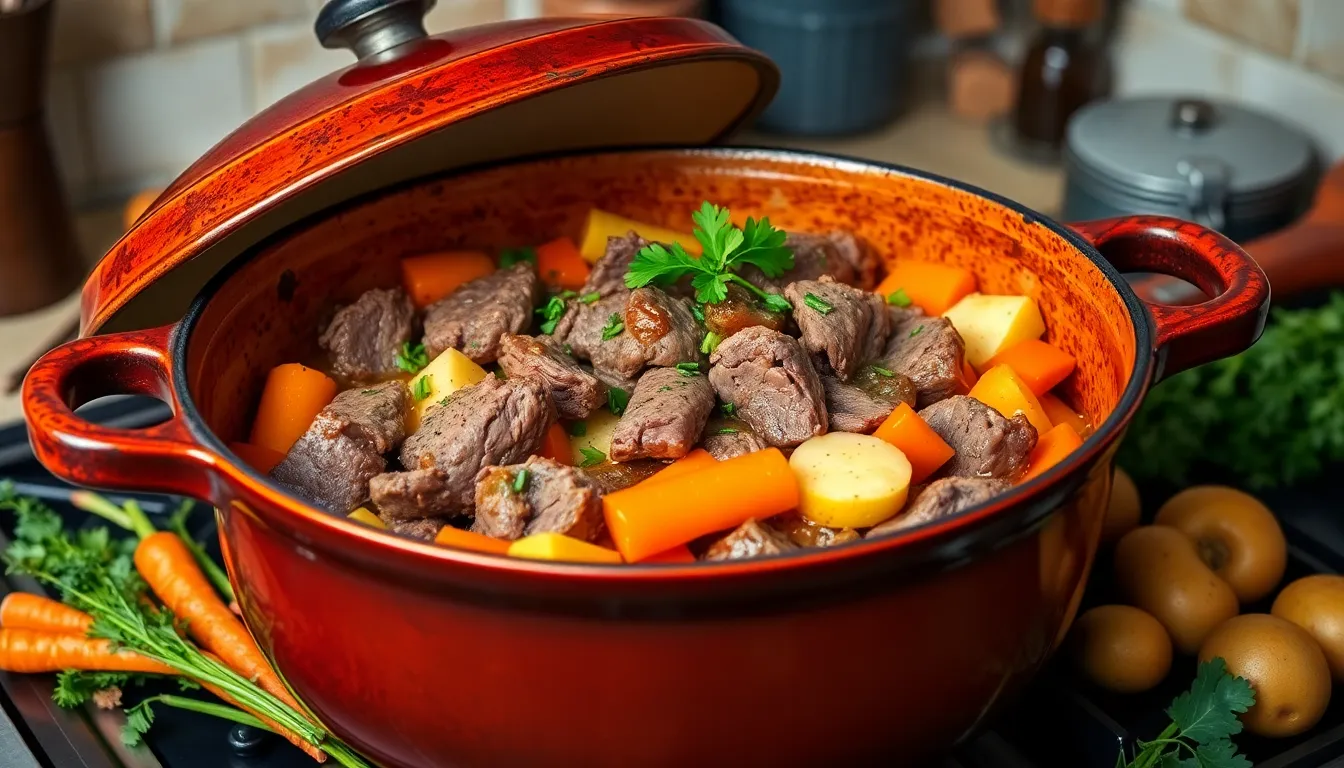
We’ve discovered that using a sufficiently large Dutch oven makes all the difference in achieving perfect results. Our 5.5-quart minimum recommendation ensures even cooking and prevents overcrowding, which can lead to uneven texture and flavor distribution.
Low and slow cooking transforms tough brisket into fork-tender perfection. We maintain a gentle simmer throughout the cooking process to prevent the meat from becoming stringy or dry. This patient approach allows the connective tissues to break down properly, creating that meltingly tender texture we’re after.
Skimming foam during the initial cooking phase keeps our broth clear and improves the overall flavor profile. We remove any gray foam that rises to the surface during the first 30 minutes of cooking, which eliminates impurities and creates a cleaner-tasting broth.
Strategic vegetable timing prevents overcooking and maintains ideal textures. We add potatoes and carrots first since they require longer cooking times, followed by cabbage during the final 15 minutes. This staged approach ensures each vegetable reaches perfect doneness without becoming mushy.
Resting the meat before slicing retains precious juices and improves the final presentation. We allow our corned beef to rest for 10-15 minutes after cooking, which lets the fibers relax and redistributes moisture throughout the meat. Sharp knives make clean cuts against the grain much easier.
Beer substitution adds remarkable depth to the cooking liquid. We often replace half the water with stout beer like Guinness, which contributes rich, malty flavors that complement the spiced brisket beautifully. Beef broth works equally well for those preferring non-alcoholic options.
Gentle handling preserves the integrity of our ingredients. We use wooden spoons for minimal stirring and avoid aggressive manipulation that could break apart the tender meat or vegetables. The Dutch oven’s excellent heat retention means we rarely need to adjust our ingredients once they’re properly positioned.
How to Check for Doneness
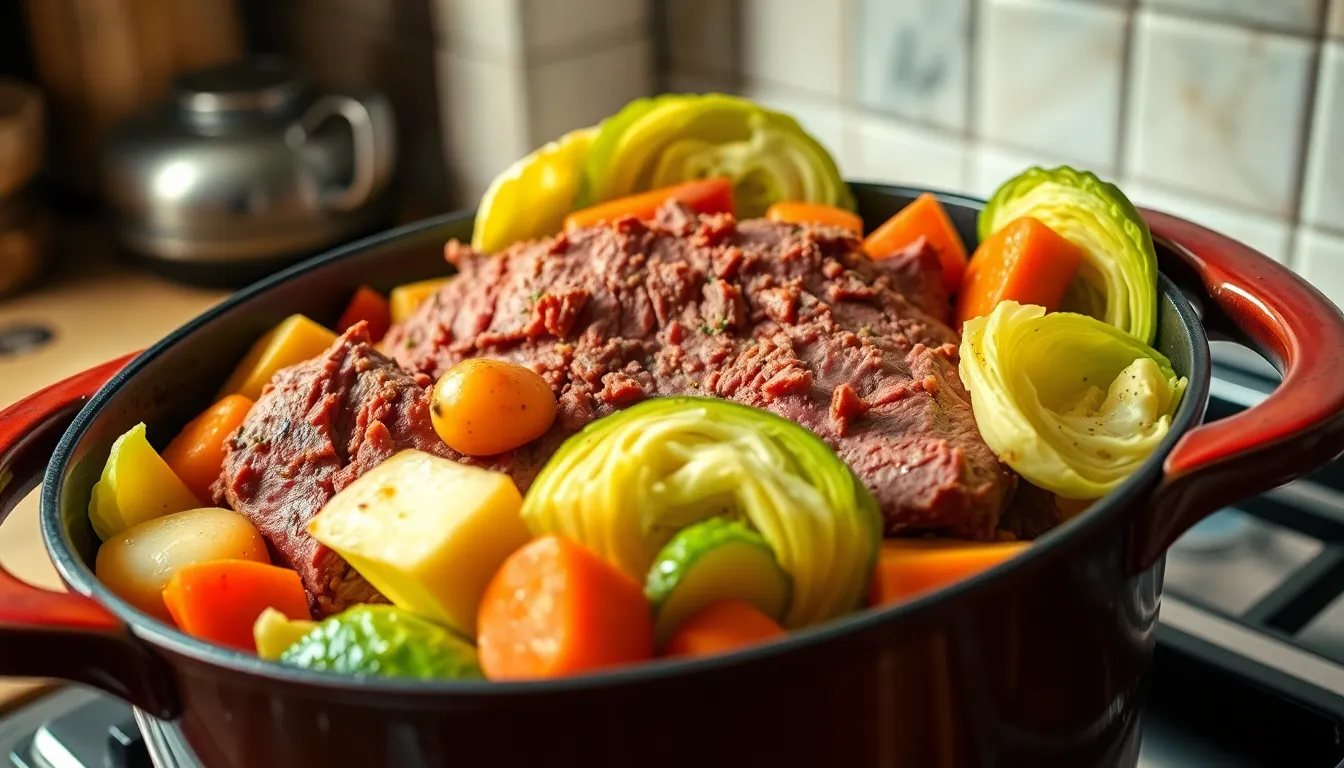
We know that timing in the kitchen can be tricky, but checking for doneness in our Dutch oven corned beef and cabbage doesn’t have to be guesswork. The key to perfect results lies in understanding the exact indicators for each component of our dish.
Testing the Corned Beef
Fork tenderness serves as our most reliable indicator for properly cooked corned beef. We insert a fork into the thickest part of the brisket and gently twist it. When the meat is ready, the fork slides in effortlessly and the beef starts to pull apart with minimal resistance. Properly cooked corned beef should feel tender throughout, never tough or chewy to the touch.
Our brisket typically requires 40 to 45 minutes per pound of cooking time. For a 3-pound brisket, we expect approximately 2 to 3 hours of total cooking time. But, we always rely on the fork test rather than timing alone, as individual cuts can vary in density and fat distribution.
Evaluating the Vegetables
Potatoes and carrots reach perfect doneness when we can pierce them easily with a fork, yet they maintain their shape without falling apart. We test several pieces to ensure even cooking throughout the Dutch oven. Overcooked vegetables become mushy and lose their appealing texture.
Cabbage wedges cook much faster than root vegetables. We look for leaves that have softened but still retain some structure and a slight bite. The cabbage should appear bright green and tender, not gray or completely wilted.
Monitoring the Cooking Process
We maintain a low simmer throughout the cooking process, never allowing our Dutch oven to reach a rolling boil. Periodically checking our heat level ensures the meat stays tender rather than becoming tough from high temperatures. During cooking, we skim off any foam that forms on the surface to keep our broth clear and flavorful.
| Component | Doneness Test | Cooking Time |
|---|---|---|
| Corned Beef | Fork slides in easily, meat pulls apart | 40-45 minutes per pound |
| Potatoes/Carrots | Tender when pierced, holds shape | 15-20 minutes after adding |
| Cabbage | Soft but structured, bright green | 15 minutes after adding |
Temperature variations and individual ingredient sizes can affect cooking times, making the tactile tests our most dependable method for achieving perfectly cooked corned beef and vegetables every time.
Serving Suggestions
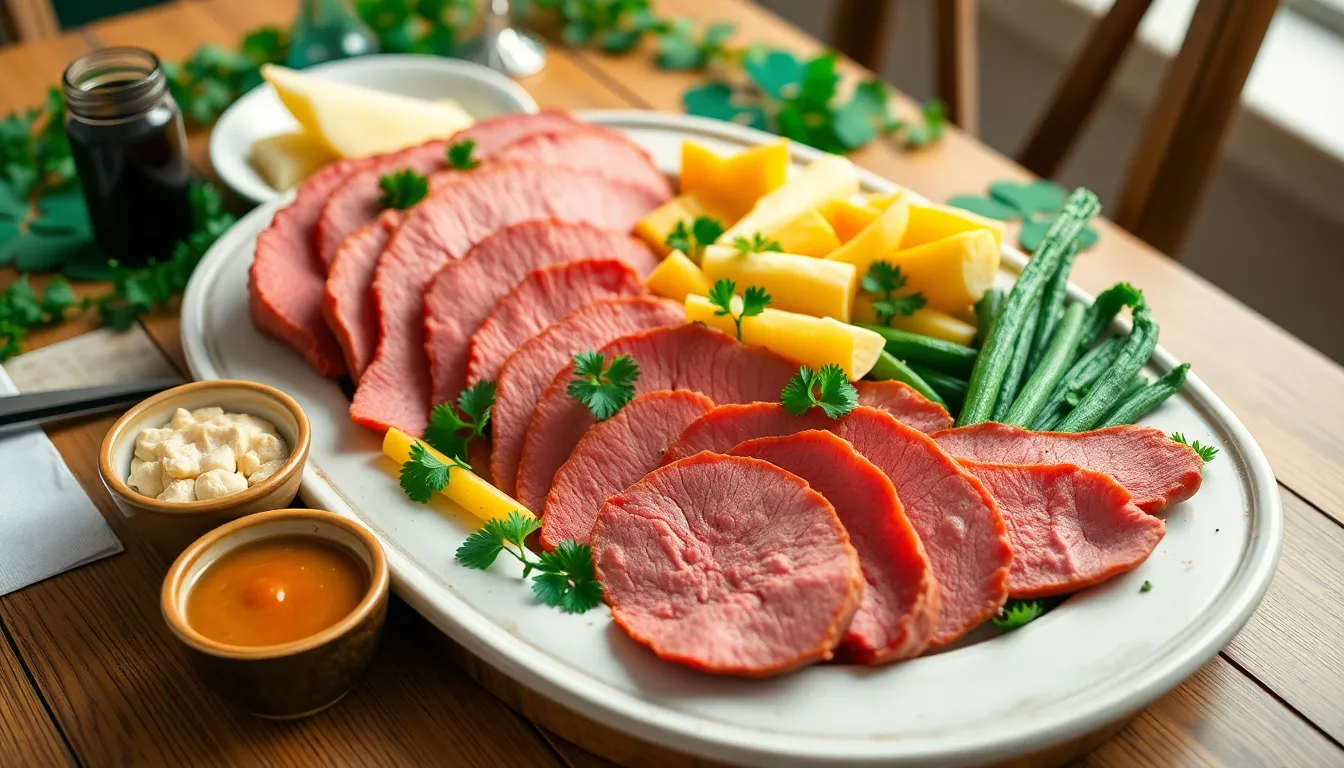
Transform your Dutch oven corned beef and cabbage into a memorable dining experience with these carefully chosen accompaniments. We recommend serving this hearty dish family-style on a large platter where everyone can appreciate the beautiful presentation of tender meat surrounded by colorful vegetables.
Traditional Accompaniments
Crusty bread or Irish soda bread makes an excellent choice for soaking up the rich, flavorful broth that develops during the slow cooking process. The bread’s texture provides a delightful contrast to the tender meat and vegetables while ensuring none of that precious cooking liquid goes to waste.
Spicy brown deli mustard serves as our preferred condiment, offering a tangy bite that cuts through the richness of the corned beef. Place small bowls of mustard around the table so guests can customize their portions according to their taste preferences.
Seasonal Presentation Ideas
This one-pot meal shines brightest during St. Patrick’s Day celebrations when the green cabbage adds festive color to your table. Garnish each serving with freshly chopped parsley to enhance the dish’s visual appeal and add a bright, herbal note that complements the savory flavors.
Consider ladling some of the seasoned cooking broth over each portion to keep the meat moist and add extra flavor depth. The liquid carries all the wonderful spices and vegetable essences that developed during the long cooking process.
Additional Serving Options
Horseradish sauce provides another traditional pairing that many guests appreciate for its sharp, warming qualities. A small squeeze of fresh lemon juice over the vegetables can brighten the entire dish and add a subtle acidic balance to the rich flavors.
| Serving Component | Purpose | Recommended Amount |
|---|---|---|
| Corned beef | Main protein | 6-8 oz per person |
| Vegetables | Side accompaniment | 1 cup mixed per person |
| Cooking broth | Moisture and flavor | 2-3 tablespoons per serving |
| Mustard | Condiment | 1-2 teaspoons per person |
Arrange the sliced corned beef against the grain on one side of the serving platter with the tender vegetables nestled alongside. This presentation method allows each person to choose their preferred combination while maintaining the dish’s rustic, homestyle appeal that makes Dutch oven cooking so satisfying.
Storage and Reheating Instructions
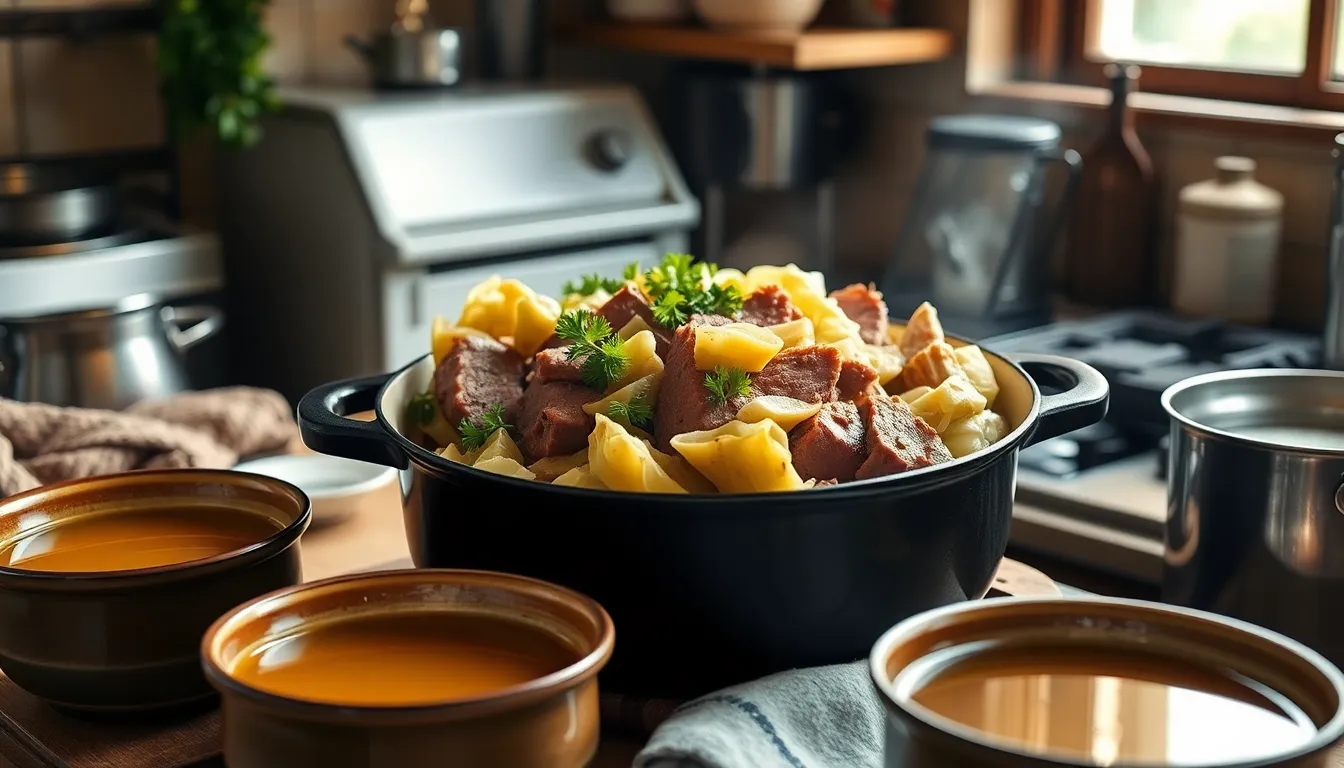
Proper storage techniques help us preserve the delicious flavors and tender textures we worked so hard to achieve in our Dutch oven corned beef and cabbage. Cool all leftover components to room temperature within two hours of cooking to maintain food safety standards. We recommend storing the sliced corned beef and vegetables together in airtight containers in the refrigerator for up to 3-4 days.
Reserve some of the flavorful cooking broth when storing leftovers to prevent the meat and vegetables from drying out. The broth acts as a natural moisture barrier and helps maintain the dish’s signature taste during storage. Separate storage containers work well if we prefer to keep the meat and vegetables apart for different meal planning purposes.
Refrigerator Storage Tips
Store our corned beef and cabbage in shallow containers to promote faster cooling and more even temperature distribution. Layer the sliced meat with vegetables and ladle enough cooking broth to barely cover the ingredients. This method prevents air exposure while maintaining the dish’s moisture content throughout the storage period.
Reheating Methods
Gentle reheating preserves the tender texture of our perfectly cooked corned beef and prevents the vegetables from becoming mushy. Place the desired portion of meat and vegetables in a covered pot with a small amount of the reserved cooking broth. Heat over low temperature on the stovetop until warmed through completely.
Microwave reheating offers convenience for smaller portions when we need a quick meal solution. Transfer the corned beef and vegetables to a microwave-safe dish and add a tablespoon or two of the cooking broth. Cover with a microwave-safe lid or microwave-safe plastic wrap and heat in 30-second intervals until the internal temperature reaches 165°F.
| Reheating Method | Temperature | Time | Best For |
|---|---|---|---|
| Stovetop | Low heat | 8-10 minutes | Large portions |
| Microwave | Medium power | 2-3 minutes | Individual servings |
| Oven | 325°F | 15-20 minutes | Family portions |
Avoid high heat during the reheating process as this can toughen the meat and break down the vegetable structure. Our goal remains to gently warm the dish while maintaining the fork-tender quality that makes this recipe so satisfying. Check the internal temperature with a food thermometer to ensure safe consumption before serving our reheated corned beef and cabbage.
Variations and Substitutions
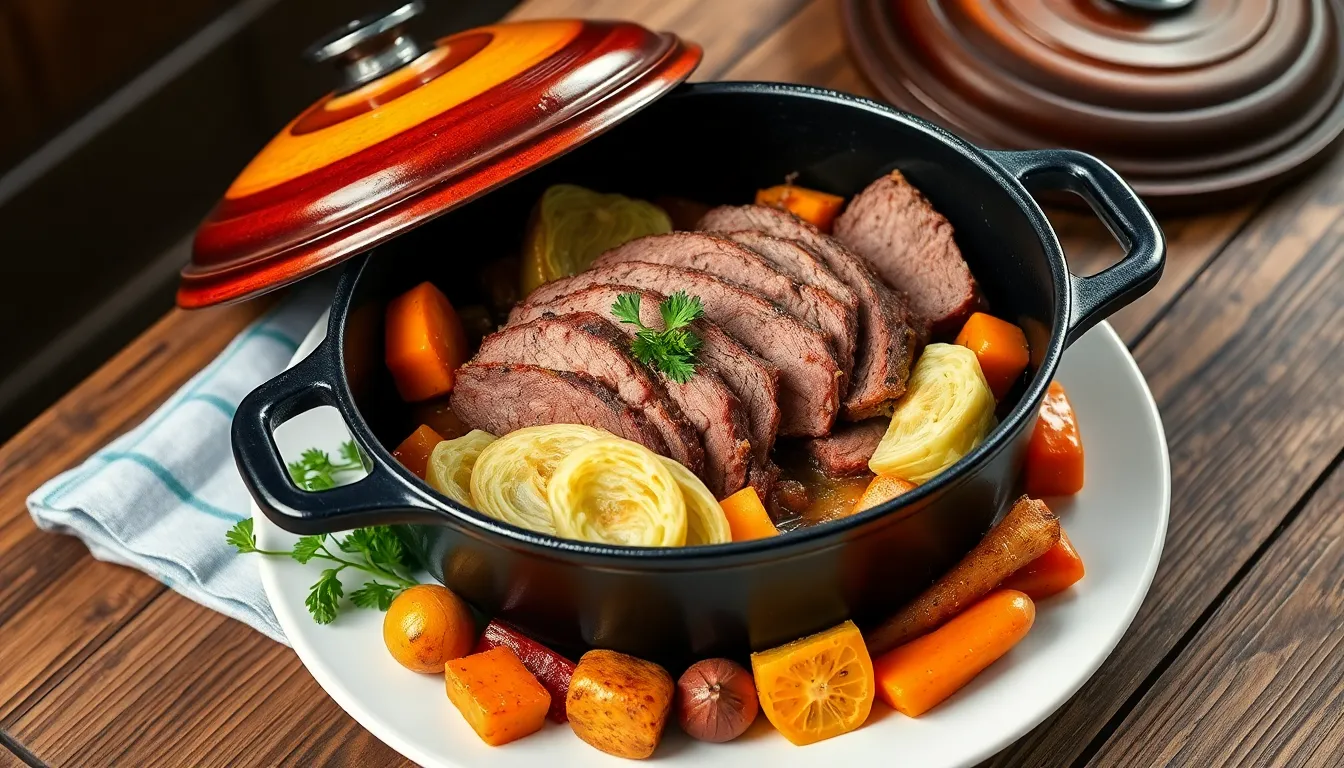
We believe the beauty of Dutch oven corned beef and cabbage lies in its adaptability to different tastes and ingredient availability. Our recipe serves as a flexible foundation that welcomes creative modifications while maintaining the dish’s traditional essence.
Liquid Variations
Water forms the standard cooking base, yet we recommend experimenting with different liquids for enhanced flavor depth. Beef broth creates a richer foundation that intensifies the meat’s savory qualities. Stout beer like Guinness adds remarkable complexity with its malty sweetness and slight bitterness complementing the corned beef perfectly. We suggest substituting up to 16 ounces of your cooking liquid with stout for noticeable flavor enhancement. Some cooks prefer using all stout instead of water, creating an exceptionally robust broth that transforms the entire dish.
Vegetable Substitutions
Our recipe accommodates various potato types based on your preferences and availability. Yellow potatoes offer creamy texture and buttery flavor, while red potatoes provide firmer consistency and slightly sweet taste. Baby red potatoes work beautifully when left whole, creating an elegant presentation. Root vegetables like turnips or parsnips make excellent additions or substitutions for traditional carrots, adding earthy sweetness and nutritional variety.
Seasoning Modifications
The included spice packet provides authentic flavor, but we encourage customizing the seasoning blend to match your taste preferences. Bay leaves, peppercorns, and cloves form the classic trio, though you can reduce or omit cloves if their intensity overwhelms your palate. Worcestershire sauce adds umami depth when stirred into the cooking liquid. Fresh garlic cloves enhance the aromatic profile significantly compared to garlic powder.
Cooking Method Adjustments
Browning the corned beef before simmering develops deeper flavor through caramelization. We recommend heating neutral oil like avocado oil in your Dutch oven and searing the brisket on all sides before adding liquid. This optional step creates a beautiful crust and intensifies the meat’s flavor profile.
Timing Alternatives
Traditional timing calls for adding all vegetables simultaneously, but we suggest staggered additions for optimal texture control. Start with potatoes and carrots during the final 1.5 to 2 hours of cooking, then add cabbage wedges only 15 to 20 minutes before completion. This approach prevents overcooking while ensuring each vegetable reaches perfect tenderness.
| Cooking Phase | Duration | Ingredients Added |
|---|---|---|
| Initial Simmer | 2-2.5 hours | Corned beef, liquid, seasonings |
| Vegetable Addition | 1.5-2 hours remaining | Potatoes, carrots, onions |
| Final Addition | 15-20 minutes remaining | Cabbage wedges |
Serving Accompaniments
We recommend pairing your finished dish with traditional condiments that complement the rich flavors. Spicy brown mustard provides tangy contrast to the tender beef, while horseradish sauce adds pleasant heat. Fresh parsley brightens the presentation and adds color contrast to the earthy tones of the cooked vegetables.
Conclusion
We’ve shown you how Dutch oven cooking transforms this classic comfort food into something truly special. The even heat distribution and one-pot convenience make this method our preferred approach for achieving tender corned beef and perfectly cooked vegetables every time.
This recipe delivers impressive results with minimal effort – whether you’re preparing it for St. Patrick’s Day celebrations or simply craving hearty comfort food. The flexibility to customize vegetables and seasonings means you can make it your own while honoring the traditional flavors.
With proper timing and our tested techniques you’ll create a satisfying meal that brings family and friends together around the table. The Dutch oven method consistently produces restaurant-quality results in your own kitchen.
Frequently Asked Questions
What size Dutch oven do I need for corned beef and cabbage?
You’ll need a Dutch oven with a minimum capacity of 5.5 quarts, though 7 quarts is preferred. The larger size ensures the 3-4 pound brisket and vegetables have adequate space for even cooking without overcrowding, which is essential for achieving tender, properly cooked results.
How long does it take to cook corned beef in a Dutch oven?
Corned beef typically requires 40-45 minutes per pound of cooking time. For a 3-4 pound brisket, expect 2 to 2.5 hours of simmering. The best indicator of doneness is fork tenderness rather than timing alone, so test with a fork to ensure it easily pierces the meat.
When should I add vegetables to the Dutch oven?
Add sturdy vegetables like potatoes and carrots during the last 30-45 minutes of cooking the brisket. Add cabbage last, cooking for only 15-20 minutes to prevent it from becoming mushy. This staggered approach ensures all vegetables maintain their ideal texture and don’t overcook.
Can I substitute water with other liquids for more flavor?
Yes, you can replace part or all of the water with beef broth or stout beer for enhanced flavor depth. This substitution adds richness to the cooking liquid and infuses the meat with additional taste. The spice packet and bay leaves will still provide the traditional corned beef flavor profile.
How do I know when the corned beef is properly cooked?
The corned beef is done when it’s fork-tender, meaning a fork easily pierces and slides through the meat with minimal resistance. Don’t rely solely on cooking time; the texture test is the most reliable indicator. The meat should shred easily when properly cooked and tender.
Should I sear the corned beef before braising?
Searing is optional but recommended for deeper flavor development. Quickly brown the brisket on both sides in the Dutch oven before adding liquid. This extra step creates a flavorful crust and enhances the overall taste, though the dish will still be delicious without searing.
How should I slice corned beef for serving?
Always slice corned beef against the grain after letting it rest for 10-15 minutes. This cutting technique breaks up the muscle fibers, making the meat more tender and easier to chew. Use a sharp knife and cut into ¼-inch thick slices for the best texture and presentation.
How long can I store leftover corned beef and cabbage?
Store leftovers in airtight containers in the refrigerator for 3-4 days. Cool the food to room temperature within two hours of cooking. Keep some cooking broth with the meat and vegetables to maintain moisture. Use shallow containers for faster, safer cooling and better storage.
What’s the best way to reheat leftover corned beef?
Reheat gently using low heat to preserve tenderness. On the stovetop, use low heat with a splash of broth. In the microwave, cover and use 50% power. For oven reheating, cover tightly with foil at 300°F. Avoid high heat, which can make the meat tough and dry.
What are the best side dishes and accompaniments?
Traditional accompaniments include crusty bread or Irish soda bread, spicy brown deli mustard, and horseradish sauce. Fresh parsley makes an excellent garnish, and a squeeze of lemon juice brightens the dish. These additions complement the rich, savory flavors of the corned beef and vegetables.







